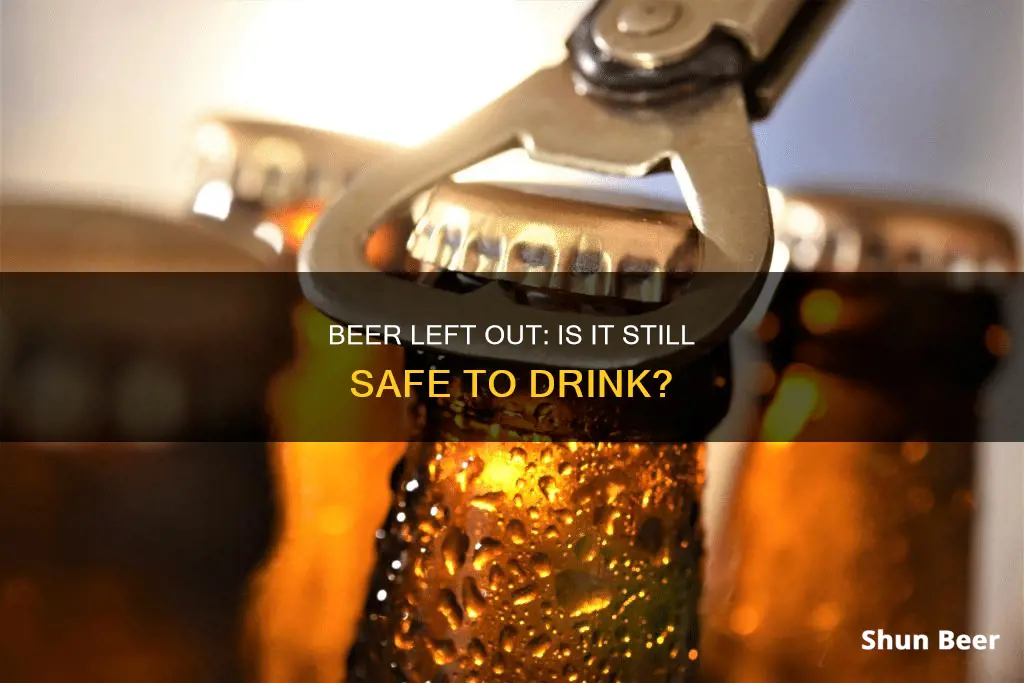
Whether you can drink beer that has been left out depends on several factors, including the type of beer, the temperature, and the length of time it has been left out. Generally, an unopened beer can last up to half a year when stored at room temperature, while an opened beer is only fresh for 1-2 days. If left out overnight, beer will likely be flat and lose its flavour, but it is still safe to drink.
What You'll Learn

Beer left out of the fridge
Beer is a beloved beverage for many, and it's important to know how to handle and store it properly, especially if it was left out of the fridge. Here are some insights on beer that was left out and how to ensure optimal taste and quality:
Beer's Shelf Life
The shelf life of beer depends on various factors, including storage conditions, packaging, and ingredients. A bottled or canned beer that remains sealed and appropriately stored can last for about 4 to 6 months at room temperature. However, once you open the bottle or can, the clock starts ticking on its freshness. An open beer is generally safe to consume within 1 to 2 days to enjoy its best flavor. After this period, the beer will start to lose its carbonation and freshness, but it can still be consumed without any significant health risks.
Temperature Considerations
Temperature plays a crucial role in maintaining the freshness of beer. While it is ideal to store beer in a refrigerator at temperatures between 35°F and 46°F, it is not always necessary. If you don't have access to a refrigerator, choose a cool, dry, and dark place like a pantry or cellar to store your beer. Avoid exposing beer to extreme temperatures, such as leaving it in a hot garage or direct sunlight, as this can ruin the beer. Additionally, rapid temperature changes are not suitable for beer, so try to maintain a consistent storage temperature.
Oxygen and UV Exposure
Oxygen exposure is another factor that affects beer's shelf life and quality. When beer comes into contact with oxygen, it can undergo oxidation, leading to flavor degradation and color changes. To minimize oxygen exposure, store your beer upright to reduce the surface area in contact with oxygen. Additionally, UV rays from sunlight can cause skunking, which is why beer is typically packaged in dark bottles. Keep your beer away from direct sunlight to prevent flavor deterioration.
Signs of Spoilage
It is essential to be aware of the signs that indicate your beer has gone bad. Spoiled beer will often develop an unpleasant smell, such as a skunk-like or urine-like odor. This could be a sign of bacterial or microorganism growth, which can make you sick if consumed. Strange tastes, such as metallic, sour, or cardboard-like flavors, are also indicators of spoilage. Cloudiness, excessive sediment, and the presence of particles or floating sediment can also suggest that your beer has turned. If you notice any of these signs, it's best to discard the beer.
Storing Beer Properly
To extend the shelf life of your beer, find an ideal storage spot that is cool, dry, and away from direct sunlight. Maintain a consistent temperature between 35 and 55 degrees Fahrenheit (2 to 13 degrees Celsius). If you have a refrigerator, store your beer in it to slow down flavor degradation. Always keep the beer sealed tightly, and store it upright to minimize oxygen exposure.
Antibiotics and Alcohol: Is It Safe to Drink Beer?
You may want to see also

Is it safe to drink?
The safety of drinking a beer that was left out depends on several factors, including the storage conditions, the type of beer, and the length of time it was left out.
Firstly, it's important to distinguish between unopened and opened beers. Unopened beers that are left out of the fridge are generally safe to drink, especially if they are stored in cool, dry, and dark conditions. However, extreme heat (above 80 degrees Fahrenheit) or direct sunlight can ruin the beer's quality and taste. On the other hand, opened beers that are left out will likely go stale and lose their optimal taste within 1-2 days. While it may not pose immediate health risks if consumed after this period, the beer's quality will be significantly compromised.
Additionally, the type of beer also plays a role in its shelf life. Beers with higher alcohol content, such as porters and stouts, can often improve with age if stored in cool, dark conditions. On the other hand, IPAs, especially hoppy ones, are more sensitive to temperature changes and gradually lose their flavour and aroma over time.
Proper storage is crucial to maintaining the quality and safety of beer. Opened beers should be sealed tightly and stored upright to minimize oxygen exposure, which can cause oxidation and affect taste. Storing beer at typical refrigerator temperatures (35°F to 46°F) can help prolong its freshness.
While drinking a beer that was left out may not always be dangerous, it is essential to watch out for signs of spoilage. Strange odours, unusual tastes, cloudiness, or mould growth indicate that the beer has expired and should not be consumed.
Drinking Beer in Public: Vietnam's Laws and Culture
You may want to see also

How does it taste?
The taste of beer that has been left out depends on several factors, including the type of beer, the length of time it was left out, the temperature, and whether it was left exposed to the elements.
If a beer has been left out for only a short period, it may still taste fresh and flavourful, especially if it was stored in a cool, dry, and dark place. However, if it has been left out for an extended period, particularly in warm or sunny conditions, the taste will likely be affected.
Beer that has been left out may develop a flat taste, losing its carbonation and becoming stale. The flavour may become less pleasant, with strange or off-flavours such as metallic, sour, or cardboard-like notes, often resulting from bacterial contamination or oxygen exposure. These flavours may be more noticeable in certain types of beer, such as IPAs, Pale Ales, and light beers, which are more susceptible to flavour deterioration.
In addition to taste changes, other sensory cues can indicate that a beer has been left out too long. These include a strange smell, such as a skunk-like odour, and a cloudy or dark appearance, which could indicate bacterial growth.
It is worth noting that while beer left out may not taste as good as freshly chilled beer, it does not necessarily indicate spoilage. Beer can be left out at room temperature for a short period without compromising its safety. However, if it has been exposed to extreme temperatures or left open for an extended period, it is best to discard it as the taste will be significantly impacted.
To summarise, the taste of beer left out will vary depending on the specific conditions it was exposed to. While it may still be safe to consume, the flavour and sensory qualities are likely to be diminished, especially if it has been left out for a prolonged period or exposed to unfavourable conditions.
Ash Wednesday: Beer Drinking and Religious Observance
You may want to see also

How to store beer
Beer storage is a complex topic, with many factors to consider, such as the type of beer, the container, and the environment. Here are some detailed guidelines on how to store beer to maintain its quality and freshness:
Choose the Right Container:
- Beer containers can include bottles, cans, kegs, or growlers, each with its own storage requirements.
- Bottled beer should be stored upright to minimize contact with oxygen, as exposure to oxygen can alter the taste and cause spoilage.
- Canned beer is generally better protected from oxygen and light, but it's still best to store them upright to reduce the surface area exposed to oxygen.
- Kegs should be kept in a cool, dry space, away from direct sunlight and other foodstuffs to prevent contamination.
- Growlers are best stored upright in a cool, dark space, and their airtight lids help maintain freshness.
Control the Temperature:
- Beer is best stored in a cool, dry place, ideally between 35-55°F (2-13°C) for bottled beer and 45-55°F (7-13°C) for packaged beer.
- Avoid extreme temperatures and fluctuations, as they can negatively impact the beer's quality and taste.
- Refrigeration is recommended to slow down the aging process, but it's not always necessary or desirable, depending on the beer type.
- For cellaring beer, maintain a temperature around 10 degrees below the beer's fermentation temperature to prevent accelerated aging and oxidation.
Protect from Light:
- Keep beer away from direct sunlight and fluorescent light, as light exposure can cause "skunking" or "lightstrike," which alters the taste and aroma.
- Brown bottles are best for blocking light and minimizing the effects of light strike, while clear bottles offer no protection.
- Store beer in a dark place, such as a basement, closet, or box, to prevent light exposure.
Consider the Beer Type:
- Different types of beer have varying shelf lives and storage requirements. For example, light beers, including pale ales, wheat beers, and lagers, should be consumed within three months of packaging.
- Heavier beers, like stouts and porters, have a longer shelf life of about six months.
- Barrel-aged beers, such as sour ales and imperial beers, can benefit from longer storage, as they have higher alcohol content and their flavors continue to evolve.
Other Considerations:
- Always seal beer containers tightly after opening to prevent oxidation and carbonation loss.
- Avoid freezing beer, as it can alter the taste and cause haze or protein clumping.
- Be mindful of humidity levels when storing beer, as high humidity can lead to mould and low humidity can dry out corks.
- Consume opened beer as soon as possible, as it will quickly lose carbonation and freshness.
By following these guidelines, you can ensure that your beer remains fresh, flavorful, and enjoyable for as long as possible.
The Science of Nostalgia: Beer Cooler Edition
You may want to see also

How to tell if beer has gone bad
Beer is susceptible to a long list of potential problems that can affect the way you enjoy it. Here are some ways to tell if your beer has gone bad:
Smell
If your beer smells like a skunk, it's likely gone bad. This is the root of the term "skunked", which many people use to describe bad beer. Beer gets skunky when it's exposed to the right combination of UV rays and coloured glass that doesn't block out the rays.
Taste
If your beer has a strange taste, it has likely expired. These flavours are often metallic, sour, or cardboard-like, and usually result from bacterial contamination or extended exposure to oxygen.
Appearance
Cloudiness is an indication of spoilage or bacterial contamination in beer. When bacteria are present, they can cause proteins and other compounds to clump together, leading to a cloudy appearance. However, note that not all beers with a hazy appearance are spoiled, as some craft beers have haze for flavour and texture.
Mould
The presence of mould in your beer indicates that it has gone bad and you should not consume it. While unopened beer rarely has mould, issues during the bottling or canning process could result in mould growth.
Pregnant and Want a Beer? Here's What You Should Know
You may want to see also
Frequently asked questions
Beer that has been left out will not cause any health issues but it will likely be flat and have lost its initial flavour.
Beer that has been opened will only be fresh for 1-2 days. After that, it will be stale and the taste will deteriorate.
The main factors are temperature, exposure to UV rays, and oxygen exposure. Beer should be stored in a cool, dry, dark place, and sealed to prevent oxygen exposure.







